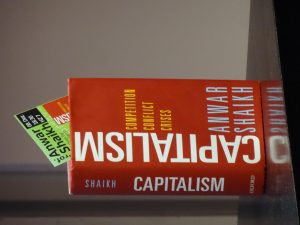Keynesian Boosts Have Not Always Worked. The Modern Classical Perspective Explains Why.
Keynesian policies – providing deficit-financed stimuli to the economy – seemed to work under Hitler in the 1930s and under Roosevelt during World War II. Why did it fail globally during the seventies and, more recently, under Lula in Brazil? Economics professor Anwar Shaikh argues the answer lies not in neoclassical or post-Keynesian theory. “There is a third way”. The 'modern classical perspective' looks at profit and wage shares.
The following text is a transcript of part of a lecture given by Anwar Shaikh: Lecture #2 (from around minute 4 to minute 17) of a series of five lectures in which Shaikh summarizes his book Capitalism: Competition, Conflict, Crises (2016). The transcript has been slightly modified by Shaikh/SE to improve its readability.
|
|---|
About the author (click)
Anwar Shaikh (1945) has been teaching economics at The New School for 42 years. Born in Pakistan, previously working with economist Robert Heilbroner and influenced by economists Smith, Ricardo, Marx, Keynes, Pasinetti, Sraffa and "the American Left" (read his full bio here). Many of his publications are freely available on his personal website.
The Third Way: Limits Operate
If we were to say “we should fight to raise wages”, what would a neoclassical economist say? What would your micro-textbook say? If you intervene in the market and you raise wages, what would happen?
Unemployment, right?
The market brings you to the real wage that gives you full employment. That’s a very important part of the theory. It’s really fundamental. Therefore, interference by raising the wage beyond what the market would do will create unemployment.
I like that about the theory. I happen to think it’s wrong but what I like about the theory is that it says what’s not possible. A better way to put it: what is not sustainable.
If we were to say “raise wages”, what would a post-Keynesian economist answer? What would be one of the implications of a rising wage almost every post-Keynesian textbook tells you?
Higher aggregate demand.
Why? Because when wages go up, consumption goes up. Consumption will therefore create higher output, higher aggregate demand, and that would cause employment to rise.
These are two different points of view. I like that. That’s a great beauty of theory. It really gives you the conflict. There are some things on which they don’t disagree but there are some things on which they do. So here’s one that’s clear. If you were to push for raising the wages of workers by twenty percent, a neoclassical would say you get unemployment and a post-Keynesian would say you get more employment. One says the unemployment rate will go up, the other that it will go down.
As an economist you are responsible for that kind of conclusion. So if you like the idea of higher wages, then you have to be responsible for the consequences. If you’re a post-Keynesian there aren’t any negative consequences, or at least the limits are pretty wide (Keynes I think wouldn’t say this but post-Keynesians would).
| Related: An interview with Shaikh on his 'radical new approach to the field of economics'. |
|---|
But I would argue that in fact there is a different way to approach this question (I can’t use the words 'third way' because Tony Blair irretrievably corrupted that word, but there’s another way).
That is to understand that, in a different framework, limits operate.
If you pump up the economy – let’s say by deficit spending, which is, any Keynesian would tell you, one of the ways to pump up the economy – you create a rise in aggregate demand. The aggregate demand rise will create an employment rise. So unemployment should go down, if the stimulus is sufficient. If unemployment goes down, then, from a classical point of view (or what I’m calling classical-Keynesian political economy), you will enter the domain where the wage share might rise. Because if unemployment goes down, wages will begin to rise. Workers will be in a stronger bargaining position. If wages rise relative to productivity, then the profit rate falls; Because the wage share goes up if the wage rises relative to productivity, and the profit share is just the dual of the wage share, so the profit share falls and the profit rate falls. And at some point that is likely to inhibit growth, because growth is driven by investment and investment depends on the profit rate. So if the profit rate is falling you are going to slow down the growth rate. The result is that, if you transcend those boundaries, you are likely to have a slowdown in growth. Which would undermine the whole purpose of the stimulus, which is to increase growth, right?
I am going to come back on this at the end of the fourth lecture I think, but this is not an abstract problem.
With this background in mind, we can look at historical episodes in which there were massive stimuli.
When Keynesianism Worked
(1) Hitler in the 1930s created what is often called the first instance of military Keynesianism – a massive stimulus to the economy, deficit finance, money printed and spent - and unemployment was eliminated in one year. Hitler is on record saying that, if you remember me for nothing else (!), remember me for this: I eliminated the problem of unemployment.
(2) World War II, the United States. In the Great Depression there was massive unemployment, misery, political turmoil, the Communist Party with a million people marching in the streets. By 1939, the war effort is beginning, and the economy is being pumped up. In the war, unemployment disappears. Now they have not enough workers, so much so that they start inviting women to work. Women were previously discouraged from working in factories and now suddenly... Rosie the Riveter! I don’t know if you have ever seen those images of a woman, with her arms and muscles. Why was that? It was to encourage women to think that factory work was good, after many years of preventing them, in fact not even allowing them to vote until two decades before this. Suddenly, they needed them. And black people were suddenly allowed in. Black people couldn’t get in there before, now suddenly they needed them. And yet that did not have negative consequences. They had in fact a tremendous increase in growth, a tremendous increase of employment, and I’m going to come back to why it didn’t have negative consequences.
When Keynesianism Did Not Work
(1) In the 1970s, so after World War II, everybody was a Keynesian. Even Nixon famously said “we’re all Keynesians now”. Why? Because it was showed, in two instances, that you could eliminate unemployment and keep the economy at a high level of employment and growth, through deficit spending. By the 1960s there was a modest goal that every government inherited, which was to maintain employment at a socially desirable level. They didn’t say “we'll make unemployment zero”. Frictional unemployment; it would be three or four percent. That was the goal. And they were going to use Keynesian stimulus policies if they needed it, to bring the unemployment down to three or four percent. So if it went above that, they would bring it down. Well, after World War II, unemployment began to reappear. And following the theory of Keynesian economics, they stimulated the economy. The unemployment went back down. So that seemed to work. But then it started coming back up, so they stimulated it more. It went back down. And then it came back up. And every time they stimulated it, they got inflation. Now they were faced with a theoretical impossibility, from their point of view, which is that they were getting unemployment rising and inflation rising. But in Keynesian theory you can’t do that because, in Keynesian theory if you stimulate an economy and you are at some level of unemployment, the employment level rises until you reach full employment, and then only after that, any more stimulus will give you inflation. So you can’t have unemployment and inflation. And you certainly can’t have unemployment rising, the employment rate falling, and inflation at the same time. That’s theoretically impossible. Yet that’s what was happening in every advanced capitalist country in the world.
(2) Most recently, in the Lula government in Brazil. The leading economists had the same premise; that you could stimulate the economy and by stimulating the economy you could pump it up. And they did pump it up in two successive governments. And then the growth began to fall, profitability fell, unemployment came back up. They lost power actually; they lost the election because of the problems that were piling up. One argument could be: well, that’s external, due to oil price changes. But the same thing happened in Argentina.
| Related: A fuller statement on these cases, including numbers and references, on Shaik's website. |
|---|
The Dividing Line
If you look at the episodes where it worked and the episodes where it didn’t, I would argue that you see a dividing line. The dividing line is that during the episodes that worked they were able to keep wages from rising faster than productivity.
Hitler had a very clear view, which was that the state controlled all of these things. So the state controlled wages. It also controlled inflation, controlled prices. I mean, you didn’t want to get on Hitler’s bad side by raising your prices, because there was scarcity. It also insisted that everybody work really hard and increase productivity. So length, intensity of the working day, as well as innovation of all sort were not just encouraged; if you didn’t do it you could be in big trouble.
What happened with the profit rate in Hitler’s great stimulus was that it rose. So you had this big rise in employment, rise in the real wage, but productivity rising much faster, and the profit rate rising.
The very same thing happened in the United States in World War II. They controlled wages, they controlled prices. They insisted that everybody work as hard as they could until they drop. Because this was for the war effort. It was patriotic. And they encouraged innovation of all sort. Because in a war you need technology to change rapidly, to develop new weapons and all of that. So, the same thing.
So those two instances that worked were instances in which the real wage increase did not go beyond the productivity increase.
In the post-war period it was the opposite; real wages were rising relative to productivity. The wage share was rising and that meant the profit share and hence the profit rate was falling. And as the profit rate fell, the growth rate coming from private capital was being undermined. So you had the public stimulus and the private incentive working against each other and that led to a slowdown in growth. It’s famously called Stagflation, that episode from 1969 to about 1977-1978. Why? Because the growth rate was going down towards zero – that’s stagnation – and yet inflation was rising.
And the Keynesians lost that theoretical battle to Friedman (I mentioned this last time). Friedman said ‘well, there’s no unemployment, I don’t know what you guys are talking about. Those people not working, that's because they choose not to work. Therefore, there's actually full employment and every time you stimulate the economy you get inflation’. Bingo, that was Friedman’s Nobel prize.
I’m going to argue that that was also wrong. But what was right about the discussion was the recognition that theory has consequences, has implications, and you’re responsible for the implications of your theory. So you can’t just adopt a theory for the parts you like and then not take responsibility for the parts you don’t like. They are tied together.
This article is a transcript of part of a lecture given by Anwar Shaikh: Lecture #2 (from around minute 4 to minute 17) of a series of five lectures in which Shaikh summarizes his book Capitalism: Competition, Conflict, Crises (2016). The transcript has been slightly modified by Shaikh/SE to improve its readability.

























Comments
Post a Comment
Your thoughts...